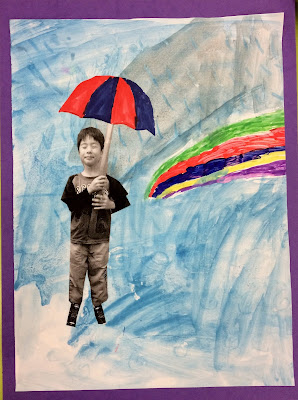 |
| By Emily |
This week we learnt about ANZAC Day by having class discussions and reading some picture books (we particularly loved the gorgeous picture book, ANZAC Biscuits by Phil Cummings, which not only had beautiful illustrations, but had some very clever comparing and contrasting, and a stunning use of figurative and sensory language). We tried an ANZAC biscuit, talked about our own ANZAC Day experiences and why we remember world wars, and looked at the symbolism of red poppies on ANZAC Day. I then introduced the children to Picasso's famous colour lithograph "Bouquet of Peace", 1958, and we discussed the symbolism of the artwork. The students at first struggled to see why it was such a clever and admired artwork... "Did he make that when he was a kid, cos it looks like a kid did it!"... but by the end of our discussion I think I had converted at least a couple of them! ;)
Lesson Materials: (per student)
1 sheet of A4 white paper with the text "We will remember them" (I made this myself)
Black sharpie marker
Some squares of red, light green, and dark green tissue paper
A glue stick
Scissors
A tea bag soaking in a cup of boiling water (cooled down in time for use!)
Lesson Steps:
1. Students held their non-writing arm up and pretended they were gripping a bunch of flowers. They then lay it down flat on their paper and traced around it with a lead pencil. Some students needed help with this. Students could also trace a friend's hand to make this step easier.
2. Students then draw in stems (I had to explicitly show and explain where and why the stems would go).
3. Students trace over their lead pencil drawing with the black sharpie marker.
4. Students use scissors to cut out a simple (no need to be neat or intricate) flower shape in a small pile of red tissue paper. Then in another small pile of red tissue paper, cut out the same shape but a little smaller.
5. After looking a photos of red poppies on the IWB, students put glue at the top of each stem, took a large flower shape, cinched it in the middle and then squashed it down on the glue, pressing in the centre so that the sides of the flower petals stuck out. They then did the same thing with a smaller red flower shape in the middle of the larger one.
6. Inside each double-petalled flower, students drew a black dot centre.
7. Students tore or cut (their choice) out green leaves and stuck them onto the stems, and used the black sharpie marker to draw the leaf veins in.
8. Finally, students squeezed their teabag into the cup it was sitting in so there were no big drips left, then dabbed it all over their artwork to create an aged effect.
Grade 2 Student Artworks:
 |
| By Clara |
 |
| By Alex S |
 |
| By ? |
 |
| By Cole |
 |
| By ? |
 |
| By Olivia |
 |
| By Nicole |
 |
| By Leon |
 |
| 2BD Artworks |










